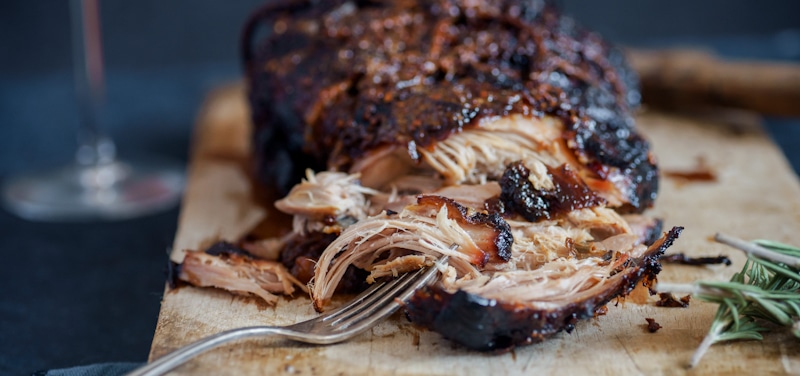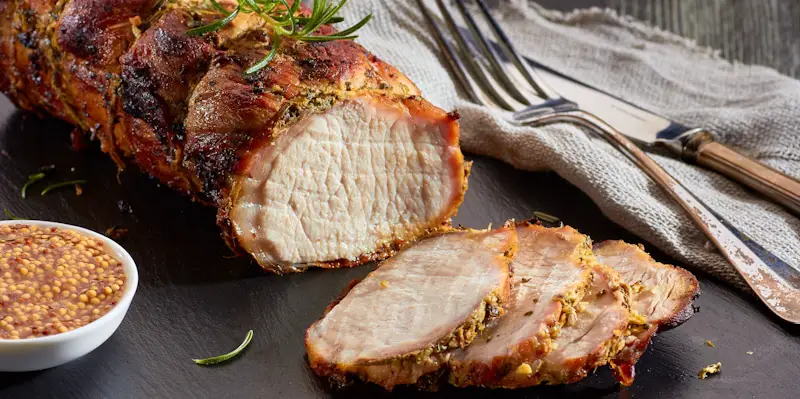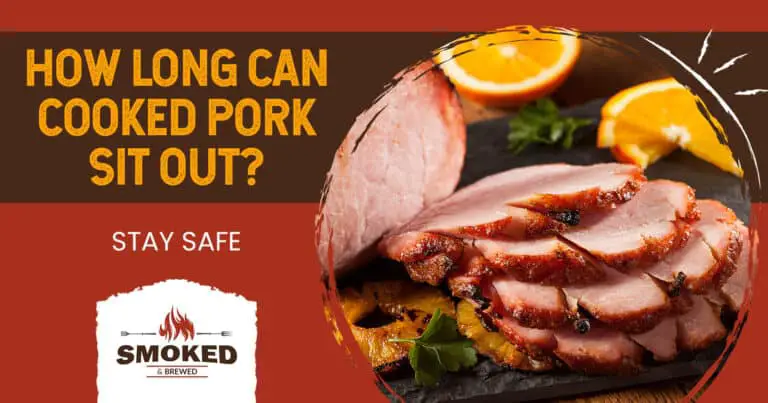Who doesn’t love to have extra portions of deliciously cooked pork at a BBQ party? But, in an unlikely event where some of your guests couldn’t turn out, and you are left with large volumes of leftovers, it is important to figure out how long can cooked pork can sit out before it goes bad.
According to the USDA, cooked pork left to sit out at room temperatures (between 40℉ and 140℉) for more than 2 hours is unsafe to consume. It leads to rapid bacterial growth, which can cause foodborne illnesses like trichinellosis. This ‘2-hour rule’ applies to all types of cooked pork meat, including baked or oven-fried pork chops, pulled pork, smoked brisket, and others.
Cooked pork that is left outside for more than two hours may not smell stale even when it has actually been spoiled by microorganisms. Therefore, to prevent chances of food poisoning, it is not advisable to consume leftover pork that has not been properly preserved. Here’s everything you need to learn about how long you can keep cooked pork outside and how to stay safe from food poisoning and other food-borne illnesses from leftover pork.
 How Long Can Cooked Pulled Pork Sit Out
How Long Can Cooked Pulled Pork Sit Out
Smoked pork is made by slow smoking of pork over wood. The cooked pork is then shredded manually and mixed with different combinations of sauces to make mouth-watering pulled pork. As advised by FDA and USDA, cooked pork that is leftover at room temperature for a maximum of 2 hours is considered safe for consumption. The warmer the room, the less time the meat should be kept out.
Sometimes when the temperature is low, cooked pork might not smell bad even after 4 hours, and many of us may consider it safe to eat. However, microbial quality testing of such leftover food will reveal that there is enough population of microbial growth which can make you ill, and thus, it is not safe to consume such food.
How Long Can Cooked Pork Chops Sit Out
The ‘2-hour rule’ for perishable food products also applies to cooked pork chops. If the meat is kept in the refrigerator after the 2-hour cut-off time, microbes will continue growing. When the pork chops give off a foul odor or have an unpleasant taste, you should discard them immediately. However, if the pork chops are deep-fried, then they can sit out for a little longer. For all other recipes, leftover pork chops should be refrigerated within 2 hours to prevent the growth of bacteria. Frozen cooked pork chops are safe to consume for up to 6 months. Cooked ground pork should be consumed within 1-2 days of refrigeration.
Why Should Pork Leftovers Not Be Consumed When Kept Out For Too Long?
Leaving pork leftovers for too long at room temperature can quickly cause bacterial overgrowth (Escherichia coli, Salmonella enteritidis, Campylobacter, and Staphylococcus aureus), especially when kept at room temperatures between 40℉ (or 4.4℃) and 140℉ (or 60℃). At such temperatures, the pathogenic bacteria can double every 20 minutes, and the food becomes unsafe to consume in no time.
A disease called trichinellosis is a food-borne illness caused by eating undercooked or raw pork or meat that is infested with worms. The disease can cause abdominal pain, headaches, diarrhea, fever, and chills. The symptoms can appear between 5 to 45 days after consuming the meat and requires antiparasitic treatment.
Reheated pork should not be consumed if it is kept outside for too long. Some bacteria, such as Staphylococcus aureus, from heat-resistant toxins that do not get destroyed even after reheating at high temperatures. So the only obvious option is to discard such stale food. Microbial spoilage can also be caused by molds and yeast.
[amalinkspro_table id=”916″ new-window=”on” nofollow=”on” addtocart=”off” /]
How To Store Pulled Pork Leftovers
Cooked pork can be stored in the refrigerator for up to two days at 40 degrees Fahrenheit or below. For storing beyond two days, you need to freeze it. The shelf-life of frozen cooked pulled pork is four months, after which the meat starts to lose its texture and flavor. Large volumes of food should be divided into small portions to ensure even cooling in the refrigerator. You can store them in shallow containers that can be covered. Do not leave any space for oxygen to get into the container.
Do remember that refrigeration only slows down the rancid process, and some bacteria such as Listeria monocytogenes can even thrive and grow in refrigerated conditions. You can also vacuum pack or dip the leftover meat in slow-simmering water if you want to preserve it for longer.
Never mix a fresh batch of pulled pork with pork leftovers from the previous batch, as it increases the chances of cross-contamination. When storing or preparing the meat, make it a point to use separate and sanitized utensils, plates, and devices each time. Follow the 4-step USDA guideline (Clean, Separate, Cook, and Chill) to minimize the chances of contamination and food spoilage.
Learn More: How Long to Let Pork Butt Rest? [COMPLETE GUIDE]
How To Thaw or Defrost Leftover Cooked Pork
There are three ways by which you can thaw cooked pork leftovers. You can either transfer frozen pork to the refrigerator section, slow cook, or microwave. For reheating frozen cooked pork, place the dish in a slow cooker (preheated at 345 degrees Fahrenheit) and allow it to get cooked for at least 20 minutes. The duration will also depend upon the quantity of cooked pork.
Make sure that there is enough room for moisture so that the meat does not turn dry. Check the internal temperature by inserting the meat thermometer into the thickest part of the pork meat. The internal temperature of cooked pork should measure 145 degrees Fahrenheit according to the USDA guidelines. Microwaved pork should be consumed immediately.
 When To Avoid Consuming Leftover Porks
When To Avoid Consuming Leftover Porks
To avoid stomach infections and other illnesses, you should not consume cooked pulled pork in the following situations:
- Rancid meat has a tangy and putrid odor. The off-odor is released when the microbes break down the meat and feed on fats, proteins, and carbohydrates. If the cooked meat has an ‘off’ smell or a sour taste or has a slimy, sticky, or discolored texture that intensifies over time, then the meat is no longer safe to be consumed and should be immediately discarded. Visible molds are also another sign of stale meat.
- Avoid consuming leftovers of cooked pork that are kept in an open and humid place. As a general rule, the warmer the room, the less time it should be kept outside.
- Never consume cooked pork if it is left for more than one hour or at an ambient temperature above the ‘Danger Zone’ of 90 degrees Fahrenheit.
- Cooked pork that is left for too long in the freezer may undergo freeze burn, which can dehydrate the meat.
- If the internal temperature (USDA recommends an internal temperature of 145 degrees Fahrenheit for cooked pork) was not properly measured before serving, or the pork was not fully cooked, you must completely avoid consuming any leftovers.
- Do not consume if the food was left overnight.
- Preparing hamburgers, curries, soup, or other recipes with stale leftover pulled pork will not affect the pathogenic nature of the meat and thus should be avoided.
If the quantity of pork required at a party is accurately calculated and the dish is cooked properly, guests will unlikely spare any pork leftovers. However, if it happens, prompt refrigeration is the only way to preserve pork leftovers. As the USDA recommends, cooked pork in any form should not be consumed after two hours. Do remember that refrigeration and freezing can decrease the juiciness and flavor of the meat.
Also read:
- How Long to Smoke Pork Shoulder at 275 [COMPLETE GUIDE]
- How to Tell if Pork Is Done
- How To Grill A Tomahawk Steak [COMPLETE GUIDE]
Scot has loved smoking food in his free time for the last few years. Each major holiday or off-weekend, Scot spends days testing and prepping new recipes for perfection.

